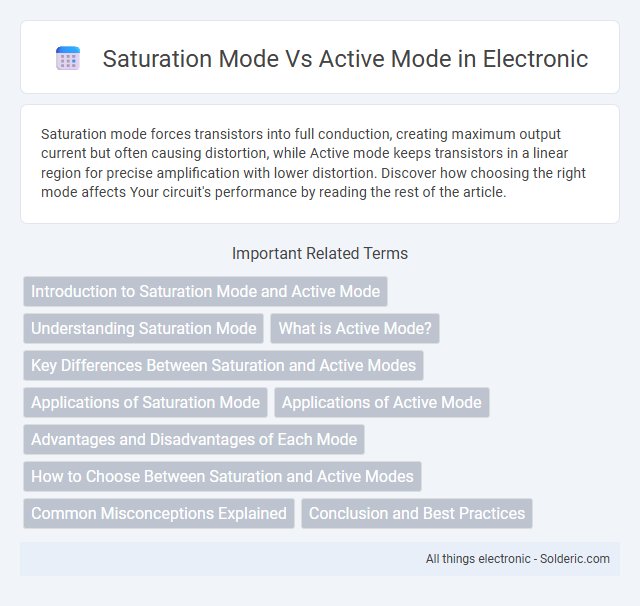Saturation mode forces transistors into full conduction, creating maximum output current but often causing distortion, while Active mode keeps transistors in a linear region for precise amplification with lower distortion. Discover how choosing the right mode affects Your circuit's performance by reading the rest of the article.
Comparison Table
| Feature | Saturation Mode | Active Mode |
|---|---|---|
| Definition | Transistor operates fully on; max collector current flow. | Transistor operates in its linear region; controlled current flow. |
| Voltage Drop (Vce) | Low (typically 0.1-0.3V) | Higher than saturation; varies with input |
| Use Case | Switching applications (ON state) | Amplification and analog signal control |
| Power Dissipation | Lower power loss due to minimal voltage drop | Higher power dissipation due to voltage drop and current |
| Operation Region | Both base-emitter and base-collector junctions forward biased | Base-emitter junction forward biased; base-collector reverse biased |
| Switching Speed | Slower turn-off due to charge storage | Faster switching compared to saturation |
Introduction to Saturation Mode and Active Mode
Saturation mode in transistors occurs when both the base-emitter and base-collector junctions are forward biased, allowing maximum current flow and causing the transistor to act as a closed switch with minimal voltage drop. Active mode features a forward-biased base-emitter junction and reverse-biased base-collector junction, enabling the transistor to operate as an amplifier with controlled current flow. Understanding the difference between these modes is crucial for designing efficient switching and amplification circuits in electronic devices.
Understanding Saturation Mode
Saturation mode in transistors occurs when the device is fully on, allowing maximum current flow between the collector and emitter, often used in switching applications for minimal voltage drop. In contrast, active mode maintains the transistor in a partially on state, enabling amplification by controlling current precisely through the base. Understanding saturation mode helps you design efficient switches that minimize power loss and achieve faster switching speeds.
What is Active Mode?
Active Mode refers to a state where a device or component operates at its optimal performance level, maintaining full functionality and responsiveness. In network communications, Active Mode enables continuous data exchange without interruptions, ensuring real-time interaction and efficient resource utilization. Understanding Active Mode helps you optimize device behavior for sustained productivity and minimal latency.
Key Differences Between Saturation and Active Modes
Saturation mode occurs when a transistor is fully on, allowing maximum current flow between collector and emitter with minimal voltage drop, while active mode enables the transistor to amplify signals with controlled current flow. In saturation mode, both the base-emitter and base-collector junctions are forward biased, whereas in active mode, the base-emitter junction is forward biased and the base-collector junction is reverse biased. Saturation mode is ideal for switching applications, while active mode is primarily used in amplification circuits due to its linear response properties.
Applications of Saturation Mode
Saturation mode is commonly used in power electronics and switching devices where maximum current flow is required to drive loads such as motors, relays, and solenoids. This mode ensures the transistor operates fully on, minimizing voltage drop and power dissipation, making it ideal for switching circuits and digital logic applications. Optimizing your circuit with saturation mode improves efficiency and reliability in high-current switching scenarios.
Applications of Active Mode
Active mode is widely used in power amplifiers, radio frequency (RF) circuits, and communication systems where precise control of current and voltage is crucial for amplification and signal modulation. It enables effective operation in transistor amplifiers, offering high gain and linearity essential for audio amplifiers, signal processing, and oscillator circuits. This mode supports efficient switching and amplification in electronic devices, making it integral for applications in wireless transmitters, data transmission, and integrated circuits.
Advantages and Disadvantages of Each Mode
Saturation mode in transistors offers high current gain and low voltage drop, making it ideal for switching applications requiring full on/off states, but it suffers from slower switching speed and increased power dissipation. Active mode provides precise control and linear amplification with faster switching capabilities, though it operates at higher voltage drops and lower current gain compared to saturation. Choosing between saturation and active mode depends on whether the priority is efficient switching or accurate signal amplification.
How to Choose Between Saturation and Active Modes
Choosing between saturation mode and active mode depends on the desired signal shaping and power efficiency in electronic circuits. Saturation mode is ideal for switching applications requiring the transistor to act as a closed switch, minimizing voltage drop and maximizing current flow. Active mode suits amplification purposes where the transistor operates as a controlled current source, enabling linear response and signal gain.
Common Misconceptions Explained
Saturation mode and Active mode differ in transistor operation, with saturation mode indicating a fully "on" state where both junctions are forward-biased, and active mode representing linear amplification with the base-collector junction reverse-biased. A common misconception is that saturation mode provides the best signal amplification, whereas it actually leads to slower switching and higher power loss. Understanding these distinctions helps you optimize transistor use in circuits for efficiency and performance.
Conclusion and Best Practices
Saturation mode offers maximum power output by driving transistors into full conduction, ideal for switching applications where minimal voltage drop is critical. Active mode enables linear amplification with precise control over current flow, making it suitable for analog signal processing and amplification tasks. Best practices involve using saturation mode for efficient switching circuits while reserving active mode for scenarios requiring linearity and signal fidelity.
Saturation mode vs Active mode Infographic

 solderic.com
solderic.com